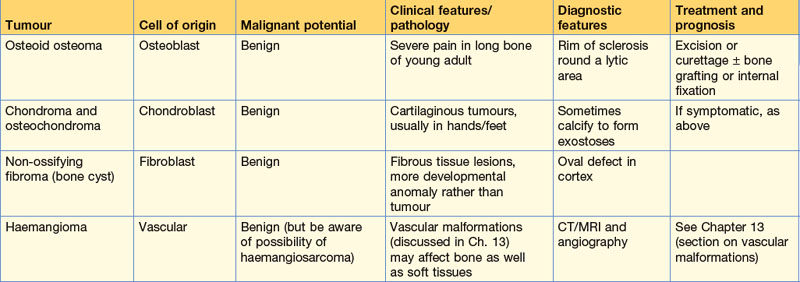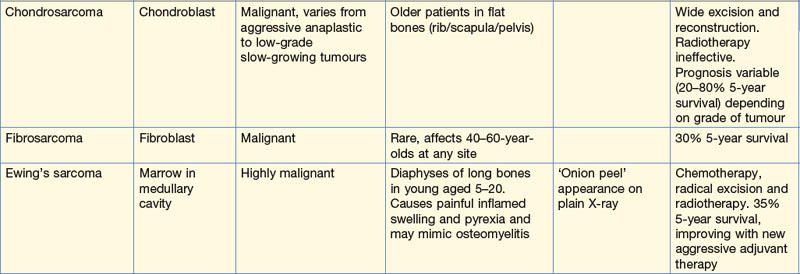19 Orthopaedics
Clinical assessment
History
Other key points to ascertain in the history include:
• occupation and right/left handedness
• past trauma (may cause osteoarthritis)
• interference with daily living (e.g. stiff arthritic hip making it difficult to put on shoes or cut toenails)
• requirement for aid (e.g. walking stick or special cutlery)
• severity of pain (night pain may indicate severe arthritis requiring joint replacement).
Examination
Look at the gait (Box 19.1), skin for scars and colour, and the general shape of the joint, swelling, lumps and position. Feel for temperature, tenderness, crepitus, loose bodies, swelling (fluid, soft tissue or bone). Measure limb lengths where appropriate. Move the limb, asking the patient to move it first to determine the range of active movements before ascertaining passive movements.
Box 19.1 Abnormal gaits
Antalgic: Painful and with a short stance phase; seen in any condition of the lower leg where the pain is exacerbated by weight-bearing, e.g. osteoarthritis of the hip
Stiff leg: A fused hip or knee joint causes abnormal swing-through when the pelvis has to be rotated to bring the leg through
Trendelenburg: With proximal muscle weakness the pelvis on the opposite side sags during the stance phase – seen in developmental dysplasia of the hip, poliomyelitis and in osteoarthritis of the hip
Short leg: During the stance phase, the short leg results in the pelvis and shoulder on the affected side sagging down
Shuffling: Seen in Parkinson’s disease, it has a short swing-through and no real heel strike or toe off
Stamping: The swing-through phase is abnormal with a broad base and high stepping – often caused by peripheral neuropathy with tabes dorsalis
Ataxic: Broad-based with unsteadiness on turning – cerebellar disease, multiple sclerosis or head injury
Foot drop: During swing-through, the foot scuffs on the ground – an L5 root lesion, common peroneal nerve palsy or old poliomyelitis
Scissor: Occurs in children with cerebral palsy with adductor spasm, so the swing-through of one leg is blocked by the other
Investigation
Imaging
Investigations useful in imaging orthopaedic problems are summarised in Table 19.1.
| Test | Indication | Example |
|---|---|---|
| Plain X-rays | Excellent definition of most bony and some soft tissue problems | Osteoarthritis: four radiological features are loss of joint space, osteophyte formation, bone cysts and subchondral bone sclerosis |
| Arthrography | Injection of contrast into a joint space demonstrates capsule abnormalities and loose bodies | Rotator cuff tears of the shoulder |
| Tomography | Now of limited use, replaced by CT and MRI | Mandible and teeth (orthopantogram) |
| CT | Detailed information on complex bony lesions | Spine, bone tumours, pelvic fractures, fractures involving joint surfaces |
| MRI | Provides excellent detail of bone and soft tissue lesions | Spinal cord, knee |
| Isotope scanning | Technetium-99 labelled biphosphonate is concentrated in areas of increased osteoblastic activity including infected and malignant bone | Prosthetic infection, bone metastases |
Osteoarthritis (OA)
Septic arthritis and osteomyelitis
Acute osteomyelitis
This is now rare in adults who are not immunocompromised or diabetic. Young children are more commonly affected. The likely culprit organisms are summarised in Box 19.2.
Chronic osteomyelitis
This may follow unsuccessful treatment of acute osteomyelitis or an open compound fracture, or may be a consequence of an infected joint replacement. The condition may be complicated by pathological fracture, amyloidosis and malignant change (squamous cell carcinoma in a sinus tract). Well-recognised versions of chronic osteomyelitis are summarised in Box 19.3.
Box 19.3 Recognised types of chronic osteomyelitis
Complication of acute osteomyelitis – prevent with prompt treatment of acute infection
Complication of open compound fracture – prevent by early appropriate treatment of compound fractures
Infected joint replacement arthroplasty
Tuberculosis – now less rare, when seen in the spine may lead to vertebral collapse and cord compression (Pott’s paraplegia). Immunosuppressed patients at higher risk
Mycotic infection – long bones and spine
Syphilis – now rare. Congenital syphilis causes infection of the growth plates
Brodie’s abscess – well-defined walled-off abscess in long bone (usually from acute osteomyelitis)
Tumours of bone
Signs of bone tumours
Search for a primary tumour. A bony lump may be palpable, which may be tender.
Primary bone tumours
Primary bone tumours are not always easily classified as benign or malignant: there is an intermediate group which are locally invasive but do not metastasise. Distinguishing benign from intermediate and more dangerous lesions may be problematic. In contrast to bony metastases, malignant primary bone tumours are rare, with fewer than 500 cases per year in the UK. The characteristics of primary bone tumours are summarised in Table 19.2.
Upper limb
Shoulder
Symptoms
Investigation
• Plain X-rays: demonstrate arthritis and abnormal calcification.
• Arthrography: now superseded by MRI but commonly used in the past to demonstrate rotator cuff tears (supraspinatus, infraspinatus, teres minor, subscapularis) by leakage of contrast into the subacromial bursa.
• CT/MRI: of increasing value.










